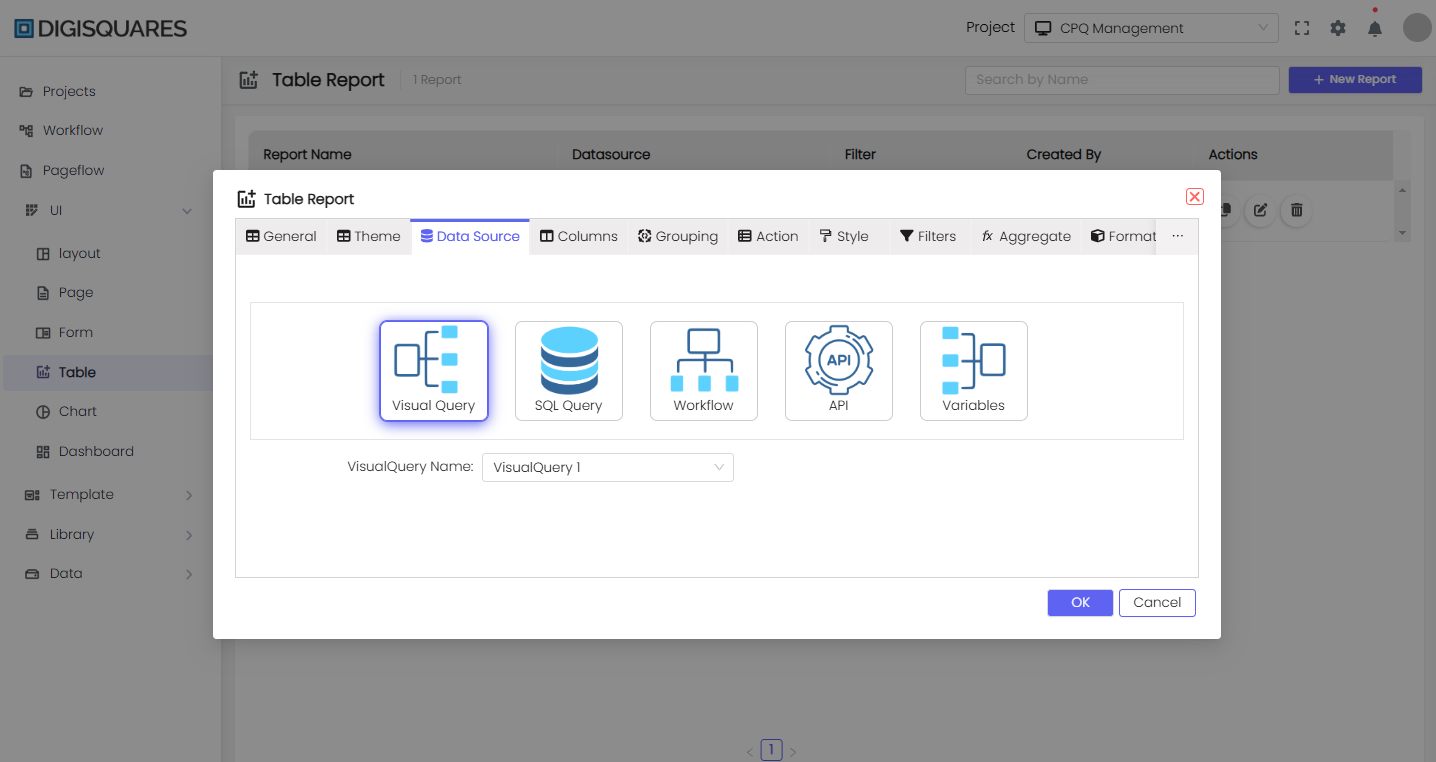Table
Report refers to a document or visual representation that presents data, information, or insights in a structured and often formatted manner. Reports are typically generated from data stored in databases, spreadsheets, or other data sources, and they are used for various purposes such as business intelligence, analytics, decision-making, and communication.

Report Creation in Digisquares
1. Data Source
The first step in creating a report is selecting the data source from which the report will retrieve information.In Digisquares platform, you can typically choose from various data sources, including Workflow, databases, APIs, Visual Query and SQL Query.
Steps to Follow :
- Access the report creation interface.
- Choose the "Data Source" option.
- Select the appropriate data source type (e.g., database, API endpoint).
- Configure the connection details (e.g., URL, credentials).
- Define the query or data retrieval mechanism.

2. Grid Style
The grid style determines how data is presented in the report. You can customize various styles such as header,subtext,grid,row,even row and row item to match your desired aesthetic.
Steps to Follow :
- Access the report design or formatting section.
- Modify the grid style settings.
- Customize header style, subtext style, grid style, row style as needed.
- Preview the changes to ensure the grid style aligns with your design preferences.
3. Column Configuration
Configuring columns involves specifying which data fields from the data source should be displayed in the report. You can also define column headers and set their properties.
Steps to Follow :
- Access the report design or configuration section.
- Select the "Column Configuration" option.
- Add columns from the data source.
- Define column headers and properties (e.g., width, alignment).
- Rearrange columns as needed.
4. Filters
Filters allow users to narrow down the data displayed in the report by applying specific criteria. Users can interact with these filters to refine the report's content.
Steps to Follow :
- Access the filter configuration section.
- Add filter options based on relevant columns.
- Define filter types (e.g., text, numeric, date).
- Specify default filter values if applicable.
5. Aggregation
Aggregation enables you to summarize and analyze data in the report. You can apply functions like sum, average, count, etc., to specific columns.
Steps to Follow :
- Access the aggregation settings.
- Choose the column(s) to aggregate.
- Select the aggregation function (e.g., sum, average, count).
- Define grouping and sorting if necessary.
6. Merge coloumn
Merge coloumn allows you to combine the content of multiple columns into a single column for a more concise presentation.
Steps to Follow :
- Access the Merge coloumn configuration.
- Choose the columns to merge.
- Define the separator or format for merged content.
- Specify the formatting rules (e.g., currency, date format).
- Add styles to the coloumn
7. Format Columns
Format columns involves applying styles, such as number format, date format, or custom format, to improve the readability of data.
Steps to Follow :
- Access the column format options.
- Select the column(s) to format.
- Specify the formatting rules (e.g., currency, date format).
- Add styles to the coloumn
- Preview the formatted data to ensure it meets your requirements.
8. Print Reports
Once your report is configured and styled to your liking, you can provide options for users to print or export the report in various formats, such as PDF or Excel.
Steps to Follow :
- Access the report export/print settings.
- Define export options (e.g., PDF, Excel).
- Implement a "Print" or "Export" button within the report interface.
- Allow users to select their desired export format.
Summary
Digisquares platforms can be valuable for UI report creation in web app development, especially for projects with straightforward reporting needs or when non-technical stakeholders need to actively participate in the report design process. However, for large, complex, or highly customized reports, it's crucial to assess whether the digisquares platform's capabilities align with your project's requirements and long-term goals.